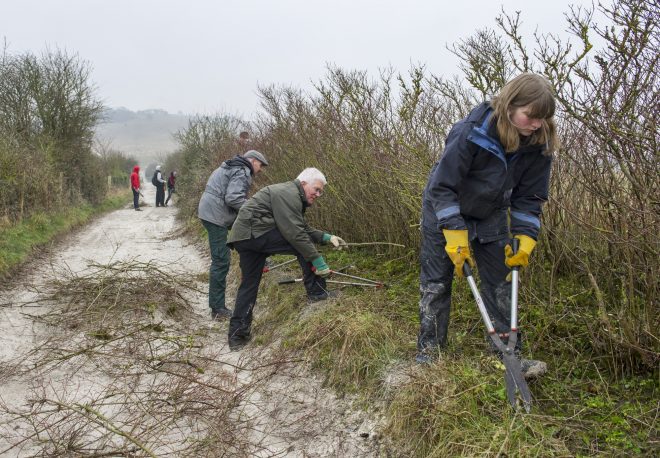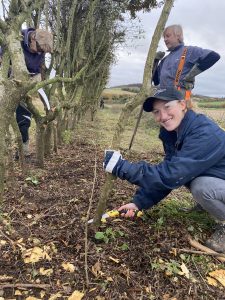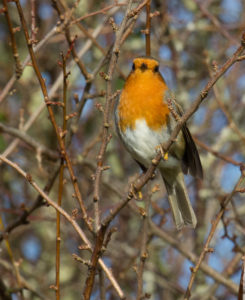Winter volunteering in the South Downs National Park
December 4, 2023

With the change of seasons comes a distinct shift in the profile of a ranger’s work and in turn the activities of our wonderful volunteers.
If the faraway first green flushes of spring felt like a reward for the travails of the previous winter, then summer has been a time for planning: monitoring the success of past projects and refining preparations for new ones.
From a habitat management perspective, autumn and winter is when our volunteers are as busy as ever.
The National Park’s volunteers come from all walks of life and every volunteer, no matter how much time they can give, is an integral part of conserving and enhancing this treasured landscape. Ultimately, it’s all one big National Park family of working towards a common goal – helping nature thrive and keeping the South Downs a special place for everyone to enjoy, now and in the future.
While the focus of summer could be counting butterflies and poring over wildflower keys, winter sees a shift in focus to coppicing, hedge-laying and tree planting.
Autumn and winter are the season for helping our woodland habitats. Managing woodland for produce as well as biodiversity gives a real sense of achievement, whether coppicing hazel or felling conifers to restore plantations on ancient woodland sites.
Well-ordered piles of stakes and binders for use in hedge-laying projects, chestnut fencing materials or cord-wood stacked up to be processed for charcoal or firewood are a joy to behold, and it’s satisfying to know that the light streaming through the opened canopy will bring new life in the spring.
 Rangers and volunteers alike often get asked what it’s like working outdoors in the cold and wet of winter, and the truth is they love it! In practice they can usually avoid the most extreme weather and the crisp, fresh autumnal mornings offer some of the finest sights in the South Downs: the russet hues of the changing leaves on Ebernoe Common, or a temperature inversion over the Arun valley.
Rangers and volunteers alike often get asked what it’s like working outdoors in the cold and wet of winter, and the truth is they love it! In practice they can usually avoid the most extreme weather and the crisp, fresh autumnal mornings offer some of the finest sights in the South Downs: the russet hues of the changing leaves on Ebernoe Common, or a temperature inversion over the Arun valley.
From a wildlife perspective, highlights of the autumn and winter volunteering include the drama of the deer rut, the vibrant colours of woodland fungi such as amethyst deceiver, chicken of the woods and fly agaric, and epic starling murmurations. There’s always something interesting to spot, and the variety brought by the change in seasons is one of the things that makes a volunteer’s role so interesting and enjoyable.
Regular volunteering can be incredibly rewarding and help physical and mental well-being.
With lots of outdoor-focused organisations looking for volunteers there’s something out there to suit everyone, regardless of your age or fitness level. If you’re interested in volunteering for the South Downs National Park, finding out more about our Youth Action programme for young people aged 16-25 or learning about how to micro-volunteer, have a look at the volunteering section on our website here
Five Quick Ways to Volunteer this Winter
Micro-volunteering is a great way to make a difference quickly and is something you can easily do at home or as part of your daily routine. Here are five easy micro-volunteering activities you can do this winter to make a difference to nature and the environment:
- Litter pick – whether it’s off the pavement on your morning commute, pulling it out of the hedge on a dog walk or doing a beach clean while enjoying a seaside stroll; picking up litter when you see it can help ensure wildlife don’t ingest any harmful substances and can help prevent microplastics entering the soil system.
- Feed the birds –
 with berries thinning out and other food sources reducing, birds are on the hunt for more sustenance. If you have an outside space put out more feeders during the colder months and make sure to break any ice on ponds, or pots of water to offer a drink. If you don’t have an outside space try a window feeder – it may take a little time for them to get used to coming near a busy household but if you take a moment to sit and watch you will be treated to an up close view of these beautiful creatures.
with berries thinning out and other food sources reducing, birds are on the hunt for more sustenance. If you have an outside space put out more feeders during the colder months and make sure to break any ice on ponds, or pots of water to offer a drink. If you don’t have an outside space try a window feeder – it may take a little time for them to get used to coming near a busy household but if you take a moment to sit and watch you will be treated to an up close view of these beautiful creatures. - Record what you see – using an app like iNaturalist to record the wildlife you see throughout the winter months can help scientists to monitor species, and can be a great way to feel more connected to the nature around you whether you live in the countryside or a city.
- Rights of Way Monitoring – if you spot a broken stile, fallen tree or any signs of damage to fences or signs while out exploring the countryside, take a moment to report the issues to the relevant local highways authority. This takes only a few minutes but helps ensure everyone can enjoy the countryside safely.
- Help the little things – bugs and beetles, ladybirds and moths, bees and butterflies, and many more little creatures need a home and safe space to hide away from predators. Have a go at making a bug hotel, however big or small, these insect homes provide welcomed shelter and warmth. If you don’t have your own outside space speak to your local community or school to see if there is a place for a communal bug hotel for everyone to enjoy.
As 2023 comes to a close, we’d would like to say a big THANK YOU to all the volunteers who make such a wonderful contribution to protecting and enhancing the South Downs National Park.
